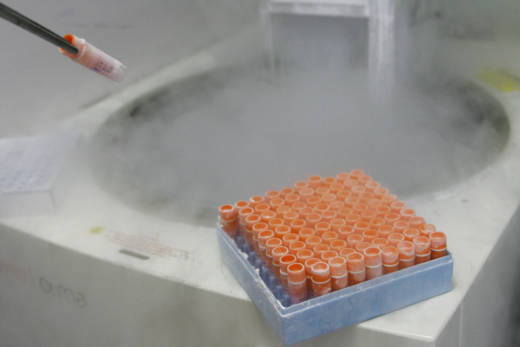The tanks rely on liquid nitrogen to keep the frozen vials at the correct storage temperature.
The clinic has not yet announced the number of people impacted, said Ho. In a statement, Pacific Fertility Center said, "The vast majority of the eggs and embryos in the lab were unaffected."
One of the company's clients includes an unnamed woman who learned on Sunday that her frozen eggs were destroyed. She has since filed a class action lawsuit against the company, seeking $5 million in damages for gross negligence stemming from a failure to properly maintain equipment. That figure is the minimum required to file a class-action suit in federal court.
Steven Tindall, the attorney for the woman, told Forum the facility lacked a real-time monitoring system that could have immediately alerted staff of a drop in nitrogen levels.
In a statement issued Wednesday, the company said it took immediate action once the malfunction was discovered:
On March 4, a single piece of equipment in our cryogenic storage lab lost liquid nitrogen for a brief period of time. We do know that there is viable tissue from this tank. The rest of the tanks were not affected and the equipment was immediately retired. The vast majority of the eggs and embryos in the lab were unaffected and the facility is operating securely. As soon as the issue was discovered, our most senior embryologist took immediate action to transfer those tissues from the affected equipment to a new piece of equipment. And we have brought independent experts and are conducting a full investigation. We are truly sorry this happened and for the anxiety that this will surely cause.
The cost of storing frozen eggs or embryos is $600 a year, according to the center's website. But the entire process can cost anywhere between $10,000 to $100,000, said the Chronicle's Ho. Aside from the financial costs, the process can be emotionally draining for prospective parents.
Some of the clinic's clients include former cancer patients who had their eggs taken out in advance of cancer treatments, Tindall said.
"Those people may have lost their opportunity to have biological children."
Ohio Incident
In a bizarre coincidence, a similar tank malfunction occurred at a Cleveland-based fertility clinic on the same day as the accident in San Francisco. The Cleveland Plain-Dealer reported that the University Hospitals Fertility Center lost frozen eggs and embryos from 700 patients. Lawsuits have been filed in this incident as well, according to The Washington Post.
The loss of potentially thousands of eggs and embryos from both clinics mark the biggest such loss on record in the U.S.
Regulations for oversight of fertility clinics vary by state. California, for example, requires clinics to be accredited by the Laboratory Field Services division of the California Department of Public Health. Ohio has no such licensing requirement.
"The United States is the Wild West of the fertility industry,” Marcy Darnovsky, executive director of the Center for Genetics and Society told the Pew Charitable Trust's Stateline in 2015.
Data shows that 1.5 percent of all infants born in the U.S. are conceived using assisted reproductive technology, according to the Centers for Disease Control and Prevention. More than 60,000 U.S. births in 2015 resulted from such methods.
The American Society for Reproductive Medicine does issue guidelines for fertility clinics, but they are not mandatory. The center has been accused of prioritizing the business interests of its members.
“It’s a field characterized by strong antiregulatory sentiment because it evolved as a business, not a research enterprise,” Arthur Caplan, director of the division of Medical Ethics at New York University’s School of Medicine, told Pew Charitable Trust.
For Taroli, the question of liability doesn't change how the experience has affected him and his partner.
"The reality is ... we've all been affected. Even if it turns out that our embryos are okay," he says, "we're still going through this madness right now of not knowing and we’re worried about whether or not they're still alive."
The Associated Press contributed to this report.

